西方文化导论Unit7
- 格式:ppt
- 大小:1.18 MB
- 文档页数:11
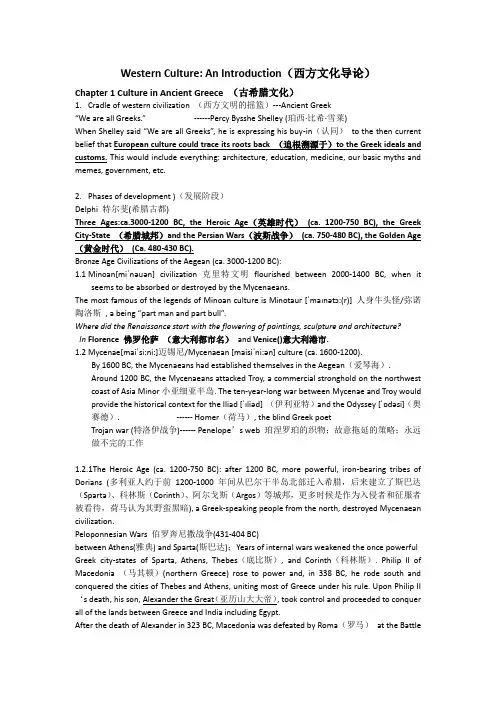
Western Culture: An Introduction(西方文化导论)Chapter 1 Culture in Ancient Greece (古希腊文化)1.Cradle of western civilization (西方文明的摇篮)---Ancient Greek“We are all Greeks.”------Percy Bysshe Shelley (珀西·比希·雪莱)When Shelley said “We are all Greeks”, he is expressing his buy-in(认同)to the then current belief that European culture could trace its roots back (追根溯源于)to the Greek ideals and customs. This would include everything: architecture, education, medicine, our basic myths and memes, government, etc.2.Phases of development )(发展阶段)Delphi 特尔斐(希腊古都)Three Ages:ca.3000-1200 BC, the Heroic Age(英雄时代)(ca. 1200-750 BC), the Greek City-State (希腊城邦)and the Persian Wars(波斯战争)(ca. 750-480 BC), the Golden Age (黄金时代)(Ca. 480-430 BC).Bronze Age Civilizations of the Aegean (ca. 3000-1200 BC):1.1Minoan[miˈnəuən] civilization 克里特文明flourished between 2000-1400 BC, when itseems to be absorbed or destroyed by the Mycenaeans.The most famous of the leg ends of Minoan culture is Minotaur [ˈmaɪnətɔ:(r)] 人身牛头怪/弥诺陶洛斯, a being “part man and part bull”.Where did the Renaissance start with the flowering of paintings, sculpture and architecture?In Florence 佛罗伦萨(意大利都市名)and Venice()意大利港市.1.2Mycenae[maiˈsi:ni:]迈锡尼/Mycenaean [maisiˈni:ən] culture (ca. 1600-1200).By 1600 BC, the Mycenaeans had established themselves in the Aegean(爱琴海).Around 1200 BC, the Mycenaeans attacked Troy, a commercial stronghold on the northwest coast of Asia Minor小亚细亚半岛. The ten-year-long war between Mycenae and Troy would provide the historical context for the Iliad [ˈɪliəd] (伊利亚特)and the Odyssey [ˈɒdəsi](奥赛德). ------ Homer(荷马), the blind Greek poetTrojan war (特洛伊战争)------ Penelope’s web 珀涅罗珀的织物;故意拖延的策略;永远做不完的工作1.2.1The Heroic Age (ca. 1200-750 BC): after 1200 BC, more powerful, iron-bearing tribes of Dorians (多利亚人约于前1200-1000年间从巴尔干半岛北部迁入希腊,后来建立了斯巴达(Sparta)、科林斯(Corinth)、阿尔戈斯(Argos)等城邦,更多时候是作为入侵者和征服者被看待,荷马认为其野蛮黑暗), a Greek-speaking people from the north, destroyed Mycenaean civilization.Peloponnesian Wars 伯罗奔尼撒战争(431-404 BC)between Athens(雅典) and Sparta(斯巴达);Years of internal wars weakened the once powerful Greek city-states of Sparta, Athens, Thebes(底比斯), and Corinth(科林斯). Philip II of Macedonia (马其顿)(northern Greece) rose to power and, in 338 BC, he rode south and conquered the cities of Thebes and Athens, uniting most of Greece under his rule. Upon Philip II ‘s death, his son, Alexander the Great(亚历山大大帝), took control and proceeded to conquer all of the lands between Greece and India including Egypt.After the death of Alexander in 323 BC, Macedonia was defeated by Roma(罗马)at the Battleof Cynoscephalae(基诺斯山战役)in 197 BC and then again at the Battle of Pydna(皮德纳战役)in 168 BC. The Greeks were finally defeated at the Battle of Corinth in 146 BC. Rome completely destroyed and plundered(掠夺)the city of Corinth as an example to other Greek cities.1.2.2The Greek City-State and the Persian Wars (ca. 750-480 BC)In 490 BC, Battle of Marathon 马拉松战役In 480 BC, Battle of the Hot Gates and Battle of Salamis 萨拉米斯海战Persian Wars(希波战争): Herodotus 希罗多德(ca. 485-425 BC), the father of history 历史之父。
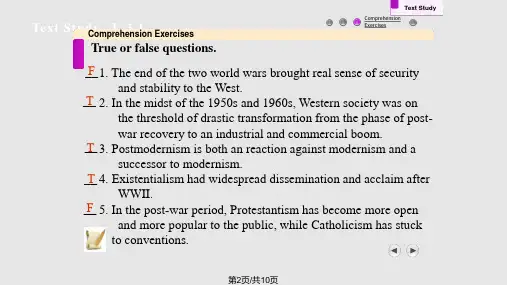

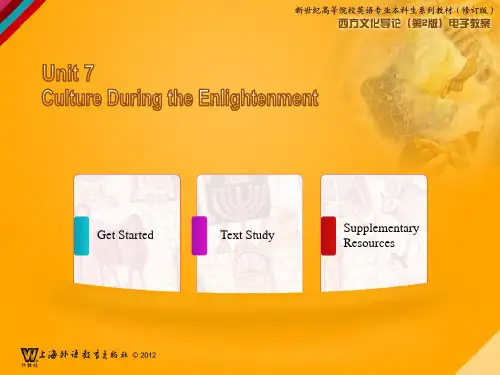
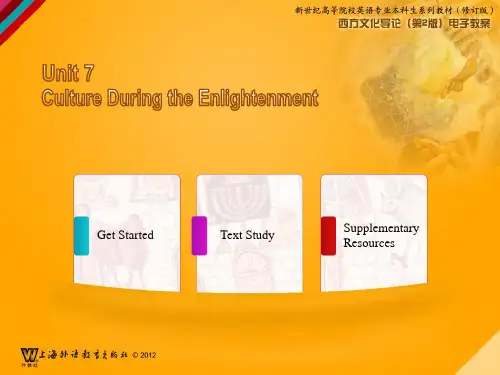
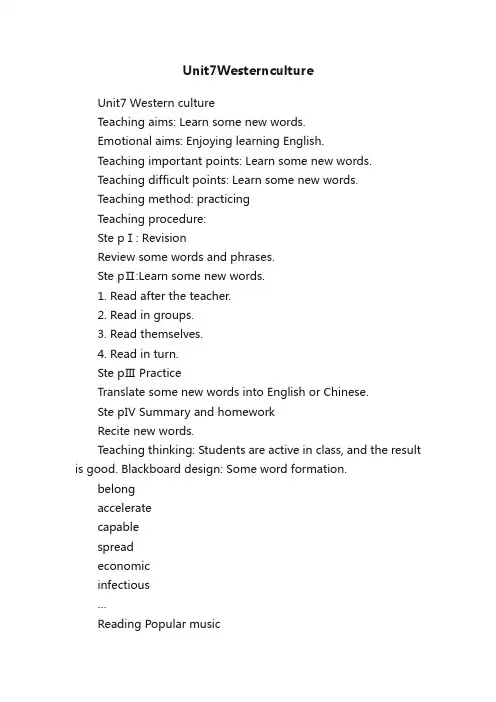
Unit7WesterncultureUnit7 Western cultureTeaching aims: Learn some new words.Emotional aims: Enjoying learning English.Teaching important points: Learn some new words.Teaching difficult points: Learn some new words.Teaching method: practicingTeaching procedure:Ste pⅠ: RevisionReview some words and phrases.Ste pⅡ:Learn some new words.1. Read after the teacher.2. Read in groups.3. Read themselves.4. Read in turn.Ste pⅢ P racticeTranslate some new words into English or Chinese.Ste pⅣ Summary and homeworkRecite new words.Teaching thinking: Students are active in class, and the result is good. Blackboard design: Some word formation.belongacceleratecapablespreadeconomicinfectious…Reading Popular musicTeaching aims: 掌握Key words 和Useful expressions的基本用法.Emotional aims: 了解流行音乐.Teaching important points: 理解课文内容,掌握课文的主要知识点.Teaching difficult points: 掌握Key words 和Useful expressions的基本用法.Teaching method: Teaching and practicing.Teaching procedures:Ste pⅠRevision检查学生预习生词和短语的情况.Ste pⅡ1.1.组织讨论Warm up中的3个问题,Do you like popular music?Do you know any western pop singers?Is singing English songs a good way of learning English?2.播放几首著名的英语流行乐曲或歌曲,回答:What kind of music did you hear just now?Can you sing an English pop song?3.讨论课文插图:Who are the four young men?约翰·列侬( John Lennon)、保罗·麦卡特尼(Paul McCartney)、乔治·哈里森( George Harrison)、斯图尔特·苏特克里弗(Stuart Sutcliffe)、彼得·贝斯特(Peter Best) What are they?4.对上述问题可给学生适当的提示,以便了解更多的信息。
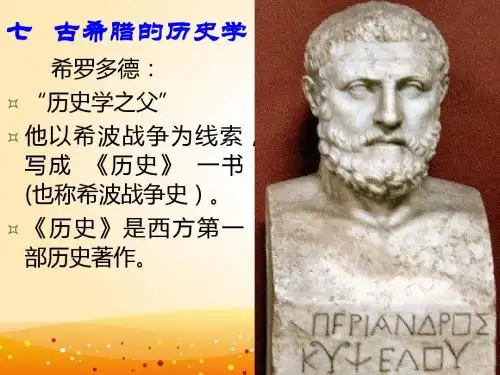
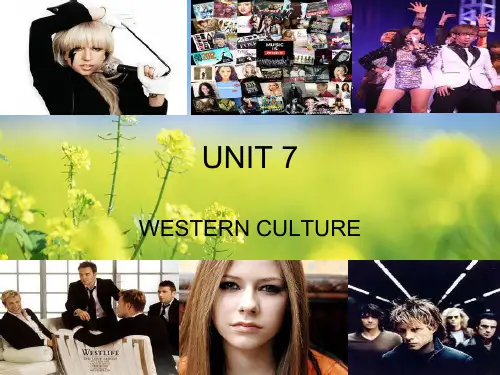
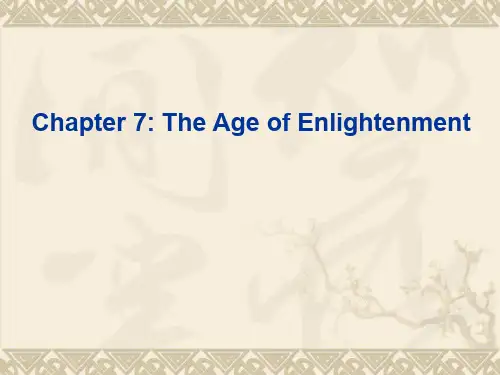


1. Please give an account of the setting of the Enlightenment.The fact that the Enlightenment first occurred in France was ascribed to the deterioration in economic, political, social and cultural conditions in the 18th-century France. The French people strongly demanded that the declining situation be arrested and reforms be carried out. Under such circumstances, progressive intellectuals began to think more seriously about the solutions to the crises and tried to resort to intellectual and social means. This movement also asked for more political power to the people as the bourgeoisie joined in with its economic support and thus the cultural movement tinned with political colour as a bourgeois mark. On the other hand, the dissemination of scientific knowledge and the influences of British empiricism also immensely heightened intellectual and political awareness of the people in general. This prepared the political basis of the bourgeois revolution to follow.2. Briefly introduce one or two representative figures of the Enlightenment and their central ideas. V oltaire and Montesquieu are two of the representative figures of the Enlightenment. Voltaire exposed the dark side of France such as the corruption and injustice of Christianity by launching his theory on human nature. Also, he argued for the freedom and equality of ordinary people. What’s more, he strongly condemned feudal autocracy and put forward the theory of the enlightened monarchy.Montesquieu’s political theory developed the principle of dividing political power although the principle itself was not his invention. Montesquieu contributed significantly to the establishment of the modern Western state by exposing the nature of state and human beings in his great work Spirit of Law which has wide-ranging influence on the later generations of modern Western political thinking and practice.For Montesquieu, it was climate that contributed most to the formation of a society and he believed it was shown in national character, political system, marriage codes, religion, and the use of slavery. His geographical and environmental theory is of some progressive significance, but it exaggerates the geographical factor in social development.1. Say something about the origin and the major concerns of Romanticism. Give examples. Romanticism originated out of the craving for individual freedom by the young intellectuals who could not tolerate ideological and intellectual oppression derived from classicism and rationalism imposed by the ruling class and traditional culture, as was demonstrated in Germany where the Storm and Stress Movement occurred under Rousseau’s influence which attracted many followers including Goethe and Schiller.To some extent it was a reaction against the Enlightenment and the 18th-century rationalism and materialism in general. It demanded more reasonable attention to human passion and individuality as a way to reach real human emancipation and freedom.The major concerns of Romanticism comprised individualism, emotionalism, worship of nature, fascination with the alien aspects of foreign lands, enthusiasm for nationalism and often expressed an air of disillusionment.2. What do you think of the similarities and dissimilarities between realism and naturalism?The similarities of realism and naturalism lie in the fact that they both aim to describe real life and try to reveal the nature of social reality, especially the dark side of human society. But in the ways of representation, they differ in the following aspects: first, the naturalist writer does not focus on a typical environment or typical characters for representation of reality, and instead, they would attempt to depict real life as it is by sticking to the inherent factor which would usually lead to thecause or motivation of certain or behaviors; second, the naturalist writer emphasizes more of the influence of environment on human nature and behavior by exposing the dark and evil aspect of human society which is not just similar to social realism but even more violent and barbarous and emotional.1.2. Choose one representative character from German classical philosophers and make a brief remark on his contribution to the later social or cultural development.Immanuel Kant was an 18th-century German classical philosopher. He is regarded as one of the most influential thinkers of modern Europe and of the late Enlightenment. Kant created a new widespread perspective in philosophy which influenced European philosophy through and after his lifetime. He also published important works of epistemology, as well as works relevant to religion, law, and history. His most important works is the Critique of Pure Reason, an investigation into the limitations and structure of reason itself. It encompasses an attack on traditional metaphysics and e pistemology, and highlights Kant’s own contribution to these areas. Kant’s great contribution lies in his interpretation of human epistemology: the ultimate nature of reality of the “things in themselves” remains forever unaccessible to the human mind and what we can know is only its phenomena. The mind impresses its forms of sensibility via space and time or the original data of the senses and orders them according to the categories of thought.1. Say something you know about Modernism, including its performance and features. Modernism, in its broadest sense, is modern thought, character, or practice. More specifically, the term describes both a set of cultural tendencies and an array of associated cultural schools, originally arising from wide-scale and far-reaching changes in Western society in the late nineteenth and early twentieth centuries. The term encompasses the activities and output of those who felt the “traditional” forms of art, architecture, literature, religious faith, social conventions and daily life were becoming outdated in the new conditions of economic, social and political developments under the influence of industrialization and colonization.Modernism —despite its complexity and multiplicity in terms of ideological tendencies and representation modes, could be regarded basically to be irrational, that is, in opposition to rational tradition of the Western culture and civilization. History has repeatedly proved that any radical drive or trend could not last long and so did modernism which, with all its justifications, only survived a few decades since its beginning and had to decline and finally disappeared as a movement though some of its ideas and forms or techniques still maintained. The reason is simple — no one could reject all the inheritances his ancestors have passed on to him no matter whether these inheritances are valuable enough for him to benefit from. In that sense people after modernism, particularly the cultural people or intellectuals, have to take a lesson from Modernist Movement, which they should be cautious about the way to handle cultural heritage and need to try to make use of the positive elements from tradition.2. Describe one or two modernist writers focused on his work.James Joyce is one of most prominent modernist writers in the early 20th century whose reputation mainly rests upon his masterful use of the Stream of Consciousness technique in his writing. He is best known for his landmark novel Ulysses (1922) and its controversial successor Finnegans Wake(1939), as well as the short story collection Dubliners(1914) and the semi-autobiographical novellet A Portrait of the Artist as a Young Man (1916). Ulysses is one of the most important works of Modernist literature. The action of novel, which takes place in asingle day, 16 June 1904, sets the characters and incidents of the Odyssey of Homer in modern Dublin and bases his three protagonists, Leopold Bloom, Molly Bloom and Stephen Dedalus, on the triangular relationship in parallel with the construction of Odysseus, Penelope and Telemachus. Ulysses’ stream-of-consciousness technique, symbolic structure, and experimental prose style—full of puns, parodies, and allusions—as well as its rich characterization in close association with serious thematic concerns, such as Irish nationalism, sympathy for the Jew and women, and protest against Catholicism, therefore renders the book a highly recognized status in Modernist literature.1. Tell some ideological Representative Figures of the Modern age and their main ideas..(1) Marx’s Marxism, its main ideas include scientific socialism, political economics, and dialectic materialism.(2) Darwin’s theory of Evolution by Natural Selection, Its main idea as follow:i. Species have developed or evolved by a series of small variations.ii. All animals and plants are descended from a single prototype.iii. Natural selection or survival of the fittest ensures that only those variations which improve the chances of survival of species are ultimately significant.iv. Only inherited characteristics can be passed on to later generations.Comet’s Positivism, including Theory of Three Stages:i. Man wanted to acquire absolute knowledge and explain the observed phenomena of the outside world with the help of supernatural theological influences.ii. Man used instead a kind of personified abstraction, i.e. metaphysical nature and “natural force”. iii. Rational sciences dominated everything.Bergson’s Intuitional Ideas:i. He was opposed to the monism of both materialism and idealism and sought a return to philosophical dualism.ii. The functions of intuition and intellect and their differences.Freud’s Theory of Psychoanalysis:i. deep-level psychology: the human unconscious was like the submerged part of an iceberg, hiding many instinctive impulses and repressed desires;ii. Three concepts: the id, the ego, the superego (choose two or three)。
Greek CultureI. Fill in the blanks:1.European culture is made up of many elements, two of these elements are considered to be more enduring and they are the Greco-Roman(希腊罗马的)element and the Judeo-Christian (犹太教与基督教的)element.2.Greek culture reached a high point of development in the 5th century.3.In the second half of the 4th century B. C., all Greece was brought under the rule of Alexander, king of Macedon.4.In 146 B. C. the Romans conquered Greece.5.Revived in 1896, the Olympic Games have become the world’s foremost amateur sports competition.6.Ancient Greeks considered Homer to be the author of their epics.7.The Homer's epics consisted of_ Iliad and Odyssey .8.The Iliad deals with the alliance of the states of the southern mainland of Greece, led by Agamemnon in their war against the city of Troy.9.The Odyssey deals with the return of Odysseus after the Trojan war to his home, island of Ithaca.10.The representation form of Greek Democracy is __ citizen-assembly._(公民大会)11.Of the many lyric poets of ancient Greece, two are still admired by readers today: Sappho and Pindar.12.Sappho was considered the most important lyric poet of ancient Greece.13.Pindar is best known for his odes celebrating the victories at the athletic games, such as the 14 Olympic odes.14.The three great tragic dramatists of ancient Greece are Aeschylus, Sophocles, and Euripides.15.Aeschylus wrote such plays as Prometheus Bound, Persians and Agamemnon.16.Sophocles wrote such tragic plays as Oedipus the King(俄狄浦斯王), Electra(伊莱克特拉(谋杀其母及其情人者), and Antigone.Oedipus complex(恋母情结)and Electra complex(恋父情结) derived from Sophocles’ plays.17.Euripides(欧里庇得斯)wrote mainly about women in such plays as Andromache, Media, and Trojan Women.edy also flourished in the 5th century B. C.. Its best writer was Aristophanes, who has left eleven plays, including Frogs, Clouds,Wasps and Birds.19.Euripides _ is the first writer of "problem plays".20.Herodotus(希罗多德)is often called “Father of History”. He wrote about the wars between Greeks and Persians.21.Thucydides(修西得底斯)described the war between Athens and Sparta and between Athens and Syracuse, a Greek state on the Island ofSicily.22.Pythagoras(毕达哥拉斯)was a bold thinker who had the idea that all things were numbers.23.Pythagoras was the founder of scientific mathematics.24.Heracleitus(赫拉克利特) believed fire to the primary element of the universe, out of which everything else had arisen.25.The greatest names in European philosophy are Socrates, Plato and Aristotle.26.In the 4th century B. C., four schools of philosophers often argued with each other, they are the Cynics(犬儒学派), the Sceptics(怀疑论学派), the Epicureans(伊壁鸠鲁学派), and the Stoics(斯多葛学派).27.Euclid(欧几里得) is well-known for his Elements《几何原本》, a textbook of geometry.28.To illustrate the principle of the level, Archimedes is said to have told the king: “Give me a place to stand, and I will move the world.”29.Greek architecture can be grouped into three styles: the Doric(多利安式)style which is also called the masculine style; the Ionic(爱奥尼亚式)style which is also called the feminine style; and a later style that is called the Corinthian(科林斯式)style.30.The Acropolis at Athens(雅典卫城)and the Parthenon(万神殿) are the finest monument of Greek architecture and sculpture in more than2000 years.II.Choice1.Which culture reached a high point of development in the 5th century B. C.?A. Greek CultureB. Roman CultureC. Egyptian CultureD. Chinese Culture2.In ___________ the Roman conquered Greece.A.1200B.C. B.700 B. C.C.146 B. C.D. The 5th century3.Which of the following works described the war led by Agamemnon against the city of Troy?A. Oedipus the KingB. IliadC. OdysseyD. Antigone4.Which of the following is NOT the plays written by Aeschylus?A. AntigoneB. AgamemnonC. PersiansD. Prometheus Bound5.Which of the following is NOT the plays written by Sophocles?A.ElectraB.AntigoneC.Trojan WomanD.Oedipus the King6.Which of the following is the play written by Euripides?A.Antigone B PersiansC ElectraD Medea7.Which of the following is NOT the greatest tragic dramatist of ancient Greece?A AristophanesB EuripidesC SophoclesD Aeschylus8.Who ever said that “You can not step twice into the same river”?A PythagorasB HeracleitusC Aristotle9.Who was the founder of scientific mathematics?A HeracleitusB AristotleC SocratesD Pythagoras10.Who is chiefly noted for his doctrine that “man is the measure of all things”?A ProtagorasB PythagorasC PyrrhonD EpicurusIII. Interpretation:1. PlatoPlato was a very famous philosopher of ancient Greece, pupil of Socrates. Plato built up a comprehensive system of philosophy. He argued that men have knowledge because of the existence of certain general “ideas”, like beauty, truth and goodness. Only these “ideas” are completely real, while the physical world is only relatively real. For this reason, Plato’s philosophy is called Idealism, an d Plato was called idealist.2. "Democracy" in ancient Greece1)Democracy means "exercise of power by the whole people", but in Greece by "the whole people" the Greeks meant only the adult male citizens.2) Women, children, foreigners and slaves were excluded from Democracy.IV. Questions:1. How did the Greek Culture originate and develop?1) Probably around 1200 B.C., a war was fought between Greece and troy. This is the war that Homer refers to in his epics.2) Greek culture reached a high point of development in the 5th century B.C.A. The successful repulse(击退)of the Persian invasion early in the 5th century.B. The establishment of democracy.C. The flourishing of science, philosophy, literature, art and historical writing in Athens.3) The 5th century closed with civil war between Athens and Sparta.4) In the second half of the 4th century B.C., Greece was conquered by Alexander, king of Macedon. Whenever he went and conquered, whenever Greek culture was found.5) Melting between Greek culture and Roman culture in 146 B.C., the Romans conquered Greece.2. What is the great significance of Greek Culture on the later-on cultural development?There has been an enduring excitement about classical Greek culture in Europe and elsewhere rediscovery of Greek culture played a vital part in the Renaissance in Italy and other European countries.1) Spirit of innovationThe Greek people invented mathematics and science and philosophy; They first wrote history as opposed to mere annals; They speculated freely about the nature of the world and the ends of life, without being bound in the fetters(束缚) of any inherited orthodoxy(正统的实践活动、风俗或信仰).2) Supreme AchievementThe Greeks achieved supreme achievements in nearly all fields of human endeavor: Philosophy, science, epic poetry, comedy, historical writing, architecture, etc.3) Lasting effectA. Countless writers have quoted, borrowed from and otherwise used Homer's epics, the tragedies of Aeschylus and Sophocles and Euripides, Aristophanes' comedies, Plato's Dialogues, ect.B. In the early part of the 19th century, in England alone, three young Romantic poets expressed their admiration of Greek culture in works which have themselves become classics: Byron(拜伦)'s Isles of Greece(《哀希腊》), Shelley(雪莱)'s Hellas and Prometheus Unbound (《解放了的普罗米修斯》)and Keats(济慈)'s Ode on a Grecian Urn(《希腊古瓮》).C. In the 20th century, there are Homeric parallels in the Irishman James Joyce(乔伊斯)'s modernist masterpiece Ulysses.Roman Culture 1I. Fill in the blanks.1. The burning of Corinth in 146 B. C. marked Roman conquest of Greece, which was then reduced to a province of the Roman Empire.2. The Roman writer Horace said: “Captive Greece took her rude conqueror captive”.(大意是:征服者反而被被征服者所征服。
西方文化导论(第二版)概述西方文化导论是一本系统介绍和探讨西方文化的教材,第二版在第一版的基础上进行了内容的更新和扩充。
本文档将对第二版的主要章节进行概述和简要介绍。
第一章:文化概念与西方文化特点第一章主要介绍了文化的概念以及西方文化的特点。
通过对文化的定义和内涵进行探讨,帮助读者建立对文化的基本理解。
接着,本章列举了西方文化的特点,包括个人主义、进步和创新、法治精神等方面。
通过对西方文化特点的分析,读者将更好地理解西方社会的价值观和行为准则。
第二章:古希腊文化的形成与发展第二章主要讲述了古希腊文化的形成与发展。
通过对古希腊城邦制度、民主思想、哲学和艺术的详细介绍,读者可以了解到古希腊对西方文化的深远影响。
本章还探讨了古希腊神话、奥林匹克运动会等与古希腊文化相关的重要话题。
第三章:罗马文化的兴盛与衰落第三章主要介绍了罗马文化的兴盛与衰落。
通过对罗马帝国的建立、法律制度、建筑艺术等方面的讲解,读者可以了解到罗马文化的辉煌。
同时,本章还探讨了罗马帝国的衰落原因,包括内外因素的影响,为读者呈现了一个全面的罗马文化画卷。
第四章:基督教与中世纪文化第四章主要探讨了基督教与中世纪文化的关系。
通过对基督教教义、圣经、修道院制度等方面的介绍,读者可以更好地理解基督教对于西方文化的影响。
本章还讲解了中世纪文化的典型特征,包括封建制度、骑士精神等,为读者呈现了一个中世纪文化的全景图。
第五章:文艺复兴与人文主义第五章主要介绍了文艺复兴与人文主义运动。
通过对文艺复兴时期的艺术、文学、科学等方面的讲解,读者可以了解到文艺复兴对于西方文化的重要意义。
本章还探讨了人文主义的核心观点与价值观,为读者呈现了一个充满思想与创新的时代。
第六章:启蒙运动与近代西方文化第六章主要探讨了启蒙运动与近代西方文化。
通过对启蒙运动的起源、思想家以及影响的介绍,读者可以了解到启蒙运动对于近代西方文化的深刻影响。
本章还讲解了近代西方文化的主要发展特点,包括科学理性主义、人权思想等方面。